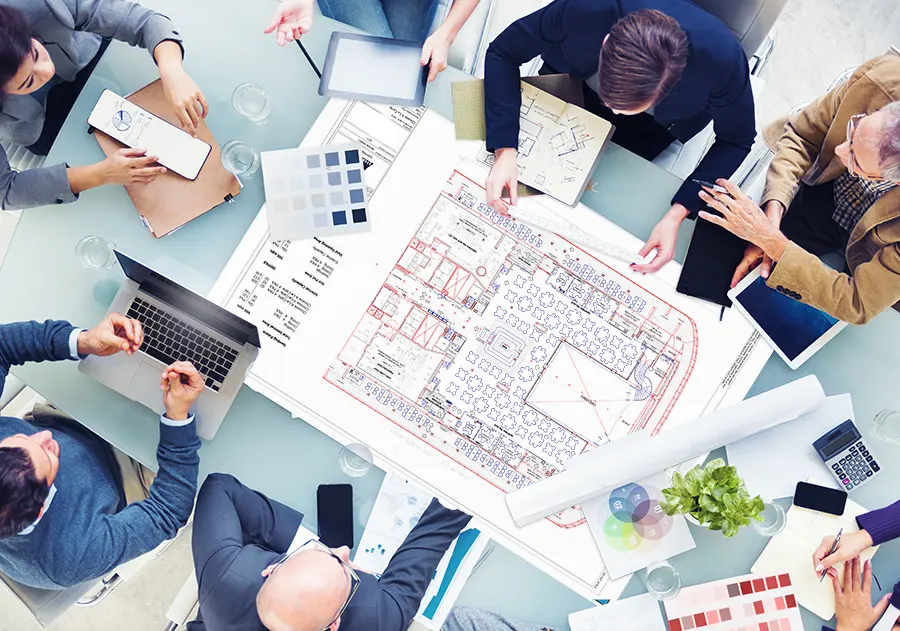What is effective meeting management in architecture firm? is the fifteenth article of a series. Articles about design management in architecture practice. I have discussed in the previous articles what is design management, who is the design manager in practice. Also, firm or project design management plan, what are the key functions of a design management plan in practice? In addition, what needs to be managed in architecture firm? This article is the Tenth article on building and writing a design management plan.
In this article on effective meeting management, I will discuss and illustrate what design managers focus on in running meetings in the firm. What factors do design managers of effective meeting management need to identify in the design management plan? Surely, to ensure the successful delivery of high-quality work on the running design project? What types of meetings are there within the architectural design process?
First of all, here I need to identify the importance of meetings in the architecture firm’s operations.
The importance of meetings in architecture firm
The four key important elements of the meetings include:
Information transfer: In general, the design manager transfers information from the Firm’s high-level to all staff. Indeed, the info related to work, and data received related to projects. In addition, info from sub-firms, and the authority updated rules. Also, the firm’s new work-related needed actions for projects.
Reporting problems: design managers are responsible for solving team technical, social problems. Surely, they prepare reports for the firm manager either to take action or for records. Problems also come from external meetings with clients and sub-firms.
Receiving instructions: design managers, depending on the organization chart level they attend meetings. They do so with higher levels to receive admin, project-related, and staff review-related orders to apply. They also chair meetings with the design team and sub-firms to pass work-related orders to apply.
Updates on ongoing projects: design managers receive updates from clients, other teams. For example, the structural team, MEP teams, and design-related update information. Updates that a team needs to reflect on the project, and study their effect and revert the results to other team members.
In practice, professional organizations circle in their publications that two types of meetings exist in practice work without identifying them. Indeed, the two types are internal and external meetings within a firm’s work. Figure 1 shows the internal meeting environment and gathering.

What types of meetings are there in architecture firm’s operations?
The architecture firm’s work includes regular meetings to smooth its work internally and externally. These include from the firm’s highest level :
Organizational meetings: meetings held between the front-line operation managers. These meetings either have a fixed schedule or are called on demand and when required. The general manager meets the finance, admin, design, and supervision teams on a scheduled timeline within the project operations. In many cases, he meets with managerial staff on the site or with clients and authorities.
Client meetings: kick-off project start meetings include most of the senior-level staff related to the project. A scheduled meeting for attendance is conducted with all related staff. Certainly, the project operations staff, with the design manager and other project engineers and architects at the senior level.
New clients and presentation meetings: In the architecture firm work the firm approaches developers, owners, and real estate companies. They present either a proposal or to present the company profile. Surely, firms do the two tasks to promote the firm and increase the firm’s visibility. These staff include the design manager, director-level, and presentation staff, architects, and others. Business development managers and marketing staff are the base of these meetings.
Administration meetings: firms inform the design managers about Admin issues. For example, staff evaluation and some critical decisions, the financial status of the project costs. Also, other decisions of firms, such as the reduction of staff. In addition, the latest info about the request for a position upgrade, along with a wage increase.
Project progress meetings: all architecture teams and other project design teams meet on the scheduled timeline. Meet to discuss the project progress and related matters such as work obstacles, actions to take, and achievements. Also, staff performance, new team members required or reduction, and project timeline.
Coordination meetings: Within the phases of the architectural design process, coordination meetings take place at a specific time. The firm or team runs meetings in the preliminary phase and every stage of the architectural design till the construction phase meetings. Within the design process, various changes and adjustments happen. A team member informs all the disciplines, and this happens in the coordination meetings for consideration.
Staff evaluation meetings: in the architecture firm, all high-level staff give reports yearly to the director level. Reports on staff performance details such as work quality, social relations, and staff development. Also, work operations requirements and compliance. Figure 2 shows the business meeting environment and the type of staff.

How do design managers do effective meetings management?
Before the meeting
- Prepare an agenda related to the subject of the meeting.
- Make sure that all attendees are aware of the meeting’s purpose.
- Only invite people who need to be there.
- Distribute the agenda and any accompanying documents in advance.
- Anyone unable to attend should communicate their apologies.
During the meeting
- The meeting chair ( design manager) walks through each item on the agenda.
- Each item on the agenda is resolved through open discussion, concluding, and agreeing on an action.
- The chairperson should manage the interruption or discussion that wanders away from the agenda.
- The meeting should start with items that could be resolved quickly, to establish a sense of peace and accomplishment.
- The design manager should appoint a member of the meeting to take notes.
- Confirm all decisions and allocate responsibility and timescale for the application.
After the meeting
- Member of the design team responsible for taking notes to prepare minutes of meetings and circulating them to all members.
Finally, for effective meeting management the design manager prepares a detailed plan of all types of meetings in a schedule for application. Regularly, to enhance the quality, knowledge, and skills of the design team.
Also, other related articles you can find in these links 1,2,3,4,5,6,7,8,9,10,11,12,13,14
[…] Also, other related articles you can find in these links 1,2,3,4,5,6,7,8,9,10,11,12,13,14,15 […]
[…] Also, other related articles you can find in these links 1,2,3,4,5,6,7,8,9,10,11,12,13,14,15,16 […]